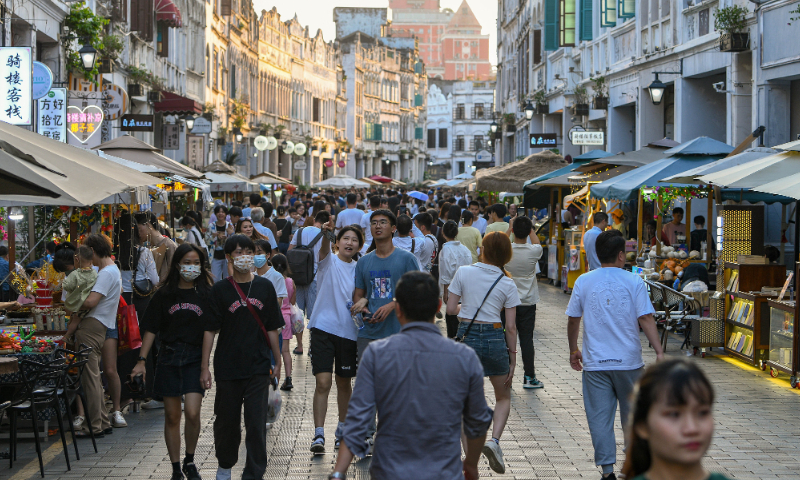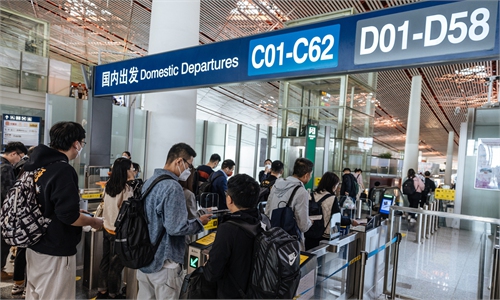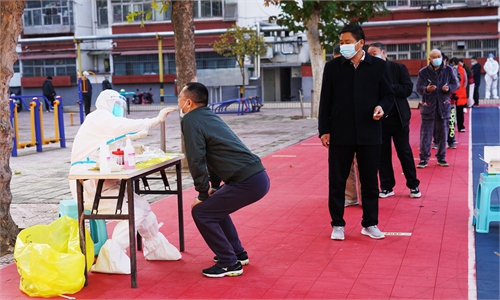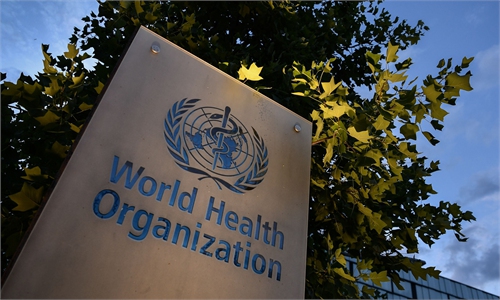
Tourists visit the old arcade street in Haikou, Hainan Province to experience the cultural heritage and taste local cuisine on April 30, 2023. Photo: VCG
South China's Hainan Province has recently seen an apparent increase in COVID-19 infections, among which 70 percent were caused by the XBB.1 variant and its subvariants. But the cases are still sporadic and pose little impact to the local medical system, the provincial government said Friday citing a local disease control and prevention expert.
Jin Yuming, an expert from the Hainan disease control and prevention center, said that data showed the infection cases in some local counties and cities had increased recently and the rate of fever patients testing positive for COVID-19 had climbed, according to a statement from the Hainan government.
Experts studied the situation and judged that the epidemic in Hainan is still at a stage of sporadic cases, according to the statement.
The XBB.1 variant and its subvariants have been detected in more than 70 percent of the cases.
But the increasing infections so far have not overwhelmed the local medical service system, affecting neither the number of visitors to local fever clinics and emergency clinics nor the number of local severe patients hospitalized in intensive care units, according to experts.
Experts called on people to enhance personal protection measures including wearing masks in public places, washing hands and maintaining social distancing. They stressed strengthened protection measures in high risk places and groups.
Increasing reports of COVID-19 have been witnessed not only in Hainan after the country experienced a tourism boom in the five-day May Day holidays from April 29 to May 3. During the period, a total of 274 million trips were made across the country.
Many people posted positive results from COVID-19 antigen tests on social media platforms during the holidays.
Amid the apparent rising trend, the Chinese Center of Disease Control and Prevention released a study on the COVID-19 re-infections in South China's Guangdong Province from December 2022 to January 2023. The study showed that the rate of re-infection with the original variant is 50 percent and that of the Alpha and Delta variants is about 35.2 percent.
The re-infection rate from Omicron is about 18.4 percent, but the rate of re-infection with Omicron three to six months after the first infection is only about 4 percent, according to the report.
The report said that 94.2 percent of re-infected patients showed symptoms and only 7.7 percent of them needed medical intervention.
The risk of the Omicron variant causing a large-scale epidemic in Guangdong is low, but supervision of new variants and investigation of the antibody level of the population is still necessary, the report concluded.
According to another report based on data from 189 countries and regions published by the center, a second wave of the Omicron-based epidemic usually occurs five to seven months after the first wave.
Some doctors in Xi'an, Northwest China's Shaanxi Province, and East China's Zhejiang Province told the media that they had observed a slight increase in COVID-19 patients in clinics recently. But these patients' symptoms were milder than those infected in earlier waves of the pandemic.
Some of the recent patients are people who had not been infected in the first wave. Those who got re-infected were mostly people who had just come back from overseas or who had close contact with returnees from overseas, a doctor named Lü Fangfang at the Sir Run Run Shaw Hospital affiliated with the Zhejiang University School of Medicine, told the media.
New variants like XBB may increase the risk of second infections, but the scale would not be as large as the first wave, Lü said.
People with weak immune systems and underlying diseases face a higher risk of re-infection, experts said. But they predicted that a second wave is not likely in China in the short term, as the majority of the population has built up immunity after the first wave of mass infections and vaccinations.
"From December until now, almost one-third of those who were not infected during the last wave are gradually getting infected. Later, more and more of those who haven't got COVID-19 will be infected, but the peak won't surpass even 10 percent of that in December last year," Wang Guangfa, a respiratory expert from Peking University First Hospital, told the Global Times.
This means there won't be heavy pressure on China's hospitals and the medical system, according to Wang, who said a second wave might come in September this year.
Global Times



